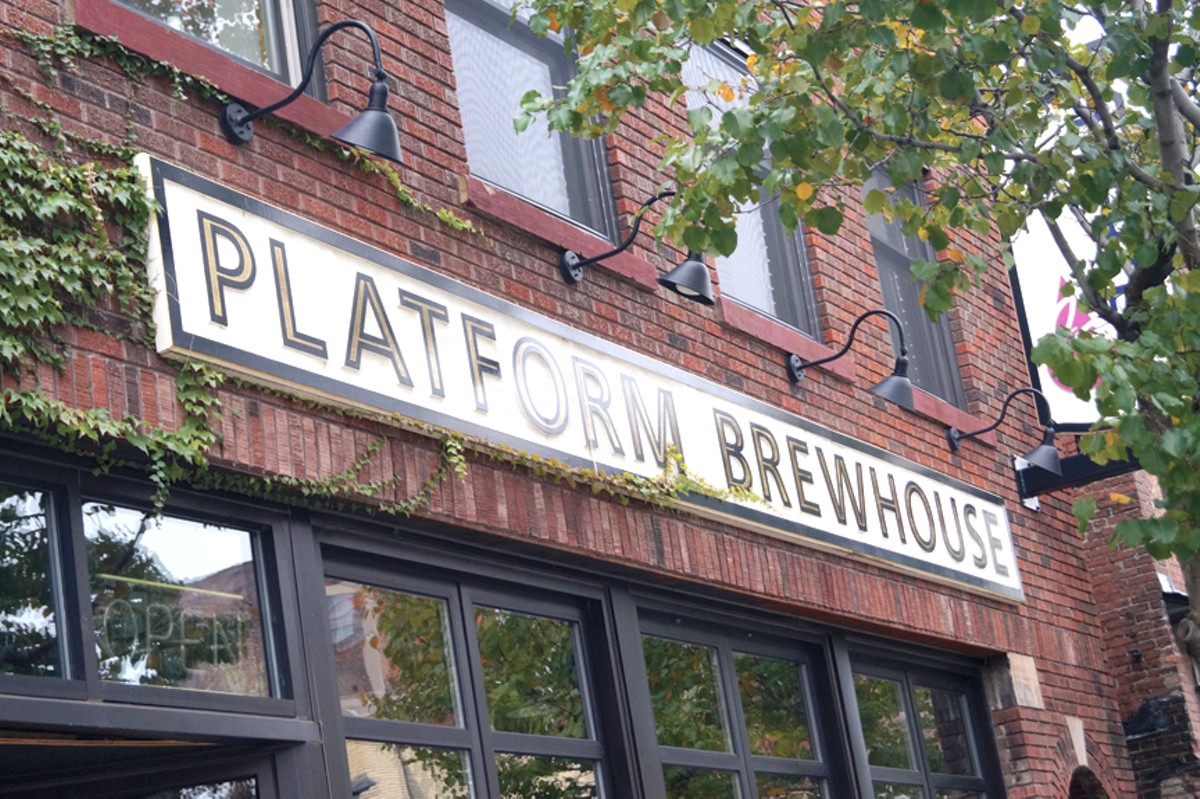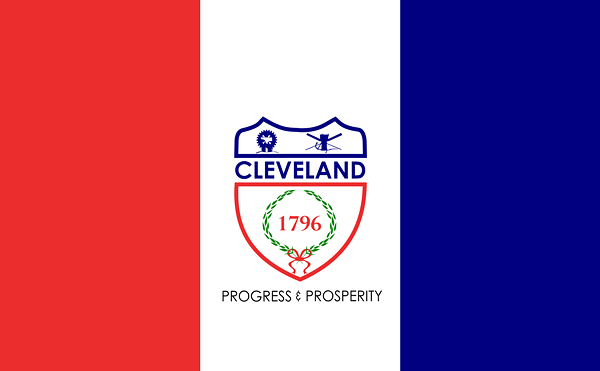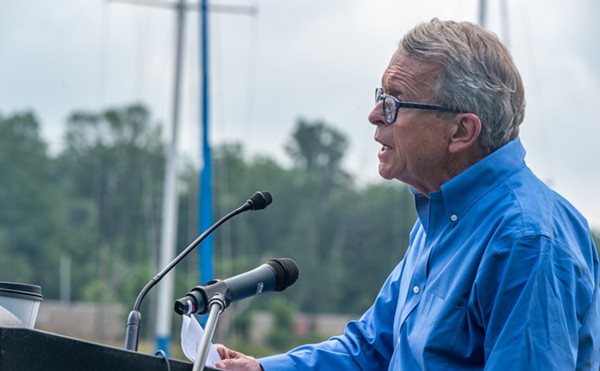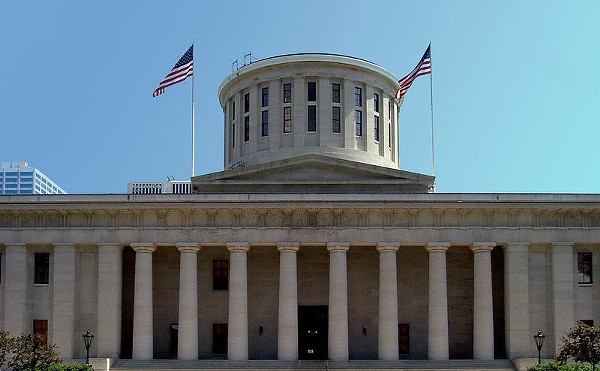Outside and atop the 35,000-square-foot Market Garden Brewery production facility, a blinking sign greets motorists as they enter the West Side Market parking lot: "Beer!" its bulbs exclaim. Inside, tanks gleam, brews ferment and souvenirs shine for tourists. This is the nerve center of MGB's operation. As such, it's got a biolab.
Labs like Market Garden's are common at bigger breweries, but they're generally regarded as last lines of defense. They're important because they help brewer-chemists (yes, a significant subset of modern brewmasters are just as comfortable in lab coats as they are in Dickies and flannel) monitor things like International Bittering Units (IBU), oxygenation levels and yeast. But they're all about assuring the quality of the product, and brewers say that quality assurance should be baked into every aspect of beer production: from the sourcing of the ingredients to the cleanliness of the brewhouse to the qualifications of the brewers themselves.
Sam McNulty is the mayor and maestro of West 25th Street's second wave. He owns or co-owns Bier Markt, Bar Cento, Speakeasy, Market Garden and Nano Brew, all on West 25th, not to mention the production facility, completed in 2015, with the capacity to produce 80,000 to 100,000 barrels of beer per year. That's roughly half the output of Great Lakes.
Great Lakes Brewing Co. is of course the grandpappy of the local scene. It's the state of Ohio's oldest and largest brewery, and a company that McNulty reveres as having been on Ohio City's "bleeding edge," back in 1988, long before it looked anything like a "destination neighborhood."
These days, of course, Ohio City is as much a destination for microbrews as it is for the West Side Market's trail bologna and fresh veggies. And the "brewery district" has expanded beyond the gullet of West 25th: Platform Brewery opened in 2014 on Lorain and West 41st Street. Forest City Brewery in Duck Island and Brick & Barrel in the Flats both opened in 2015. In 2016, Hansa House opened its doors on Lorain and West 29th after a lengthy renovation.
And the local openings continue apace. On the near west side alone, Saucy Brew Works on Detroit and West 29th is expected to open in 2017. The small Cincinnati Brewery Bad Tom Smith hopes to be open and pouring in the former Weenie-A-Go-Go location on West 25th by St. Patrick's Day. In Battery Park, Terrestrial Brewing Company is slated for a 2017 opening as well.
These announcements have been frequent enough to result in some concern among consumers about a potentially crowded market. The local conversation about the brewery explosion, the so-called "brewery bubble," has become a conversation about brewery survival. Will all these new operations make it?
The prognosis on a brewery bubble was mixed in a recent Crain's Cleveland Business special report, but the Ohio Craft Brewers Association did say that the rapid pace of brewery growth in Ohio, about 40 new breweries per year statewide, would surely slow down soon.
Local brewers all said versions of the same thing when Scene came asking about the "brewery explosion." For breweries with aspirations beyond neighborhood-brewpub status, those that intend to bottle and distribute and expand their brand's reach — think Great Lakes, Fat Head's, Market Garden — quality control is critical. Industry experts agreed: Quality is the single most important factor in determining a new brewery's success. Marketing, location, ancillary offerings, unique and abiding connections with the local community: Those are all valuable assets, and new breweries shouldn't overlook them. But if the beer's no good, the brewery won't survive.
In terms of capacity, though, there's consensus in the brewing community that Cleveland is nowhere near a critical mass.
"I think there will always be room for the neighborhood brewpub," McNulty told Scene in a recent interview at Nano Brew.
In a recent episode of the CLEcast podcast, recorded live at the Market Garden production facility, McNulty reiterated that idea when co-host Dan Huszai asked him how he felt about the breweries mushrooming up all over town, and on the near west side in particular.
"I love it," McNulty said, right away. "I know there's a lot of talk about the restaurant, bar, brewery bubble, and there's definitely a restaurant bubble, if you look at the multiple thousands of seats that have been added across the city. But in the brewery world, all we're doing is going back to what was happening in Cleveland prior to Prohibition, where every neighborhood had its own pub."
But that's not the whole story: "The distribution world, that's also a bubble," McNulty said. "There's definitely going to be some Darwinian culling of the herd."
Shaun Yasaki agrees. He's the former Platform brewmaster and original part-owner who set out on his own in late 2015. He's eyeing a spring opening for Noble Beast, his new brewery on Lakeside and East 14th Street, just a hop, skip and a jump from Masthead Brewing Company, the new brewery that opened on Superior in January. Alongside Hofbräuhaus, those two ventures will form the core of a new brewery district on downtown's northeastern flange. Yasaki told Scene that Noble Beast would operate almost exclusively as a taproom with little to no distribution.
"The idea is to sell as much as possible right here," he said. "One of the biggest struggles of the so-called bubble is distribution, getting shelf space. Opening up a $3-, $4- or $5-million dollar brewery when you don't have a brand and you're trying to find shelf space. You're competing with the rest of the country — the rest of the world — on that scale."
Among brewers, this is dogmatic. "Fine wine and imported beer" used to be the calling card of most convenience stores — you can still see the old signs — but now, craft beer is king. Local upstarts like Platform and Sibling Revelry must compete with other in-state options (Akron's Thirsty Dog, Cincinnati's Rhinegeist); big craft players (Lagunitas, Bells, Stone, New Belgium, Deschutes); plus all the low-cost, heavily marketed domestic swill. The competition is fierce.
Not so much, brewers say, for a brew-and-pour operation.
"I think the bubble is a little overblown [in that regard]," Yasaki said. "If you're a smaller brewpub bar, you're just another bar. Has anyone ever said, 'Oh, my god, there's another bar opening in Cleveland'? And if you're a brewpub, you're probably at the top of the pecking order."
Still, a culling may loom. Fat Head's founder and brewer-savant Matt Cole, for one, says that in as few as two or three years, the brewery landscape in Northeast Ohio might look drastically different.
"I think we're headed for a shake-out," he told Scene. "I'm glad to see former brewers of mine moving forward [Yasaki, for example, worked under Cole at Fat Head's]. But I'll be honest, not everybody coming out of this [brewery explosion] is making great beer. You see some breweries just kind of throwing their beer up at the wall to see if it sticks."
***
Which brings us back to the beer lab: Sam McNulty, in the spirit of collaboration, has encouraged local brewers to make use of the Market Garden's lab equipment. And one day this fall, the guys from Platform took him up on it — more than once in a single day.
They were allegedly having some issues. While the Market Garden crew thought they were dealing with an infection, the Platform crew said that brewmaster Andy Tveekrem (formerly of Great Lakes and Dogfish Head) was showing them how to use a new piece of equipment that they were in the process of buying. But for whatever reason, they wanted to test beer fresh off their production line. The rumor was, something in the Platform plant was corrupting the product's taste. And Tveekrem and the Market Garden staff counseled them to dump the batches.
Anxiety about bad batches is natural because they can sully a brand's reputation. To illustrate, Fat Head's Matt Cole referenced two enormous mishaps in 2016 by breweries in Chicago. After a wild yeast infection, Revolution Brewing Company was forced to recall 10,000 barrels (about 3.3 million cans) of six of their most popular brews. And twice last year, Goose Island Brewing Company recalled bottles of beers in their barrel-aged stout line. The company theorized that a bacteria "lurked in the tanks" used to transport the beer from the barrel-aging warehouse to the bottling facility. Neither of the infections were harmful, but the beer tasted funky, plasticky, rotten.
"With all the competition out there," said Matt Cole, "sometimes you only get one chance. And if the one time a consumer picks up your six-pack from a convenience store, it's an infected batch? That's all it takes to ruin your reputation, man. And it's a hell of an economic impact. [For Fat Head's], consistency is a huge priority. Any time we even suspect something's off, the beer will not leave our brewery. You work too hard to build up a reputation. And the consumer is a little more educated now. They're able to weed through what's good and what's bad."
Sam McNulty said he remembered, back in his Cleveland State University days, trying a six-pack of Crooked River Brewing Co. — a brewery that closed in 2002 due to financial hardship — and the beer being so inconsistent that it tasted different from bottle to bottle.
"They were cranking out beer down there," McNulty said of Crooked River. "You could open up a beer and it would not be the same as you had yesterday. That's part of what gave craft a bad name. It was like, 'You wanna charge me more, for a beer that tastes like this?'"
Shaun Yasaki left Platform in late 2015. Shortly thereafter, Platform sued Yasaki for damages stemming from an alleged breach of contract and breach of fiduciary duty. Basically, Platform didn't want him to start a competing brewery while he still owned a stake in the company, even though such an arrangement was permitted in the company's charter. According to court documents, Yasaki was "sincerely open" to the idea of selling his ownership units, but wanted to review the company's books to determine a fair price. Platform's other two owners, Justin Carson and Paul Benner, objected, arguing that Yasaki was attempting to acquire "trade secrets" which would be used against Platform when he began his new venture. The case was settled in 2016, but Yasaki declined to discuss terms.
After leaving Platform, Yasaki worked part-time at Market Garden.
"Shaun applied for a job while [Noble Beast] was in the works," McNulty told Scene. "I felt bad, but we just needed cellar work — you know, cleaning and sanitation."
So the former brewmaster at Platform was scrubbing tanks for the competition. There was an obvious takeaway for one local brewer, who asked that his name not be used because of the sensitive situation. "You've gotta spend more time on this — what your former brewer is doing," he said, of Platform, "and less time and money on marketing or whatever."
***
Platform Brewery arrived in May, 2014, just before the return of LeBron James and just after Positively Cleveland had rebranded as Destination Cleveland. The visitors bureau was heavily promoting its gritty, millennial-centered #thisiscleveland campaign, and tourism was soaring — or at least it would be soon.
Platform was the sudsy crest of the Cleveland Renaissance wave. It instantly became a representative beer, a representative brand, of the New Cleveland. This was memorialized in an early branding partnership with the Cleveland Clothing Company; remember those New Cleveland Palesner cans? Platform's industrial tasting-room was modeled after those on the West Coast. And indeed, its founders embraced with zest the rhetoric and corporate ethos of Silicon Valley.
"We are young entrepreneurs," Platform's Paul Benner, who is 34, told Scene over coffee at Jack Flaps. "We're hungry, we're aggressive, we're doing things completely different than what's been standard in the Cleveland market."
Platform's business model and its branding were intentionally oppositional. Not confrontational, exactly, but radically different. And as Benner noted, it had been six years since Fat Head's hit shelves. The market seemed ready, if not randy, for a new local product produced and sold "at a decent scale." (Both Market Garden and Westlake's Sibling Revelry Brewing Co. have moved into distribution since.)
"We positioned ourselves as this very collaborative, home-brew inspired, experimental brewery," Benner said. "We just were looking at what was there, filling those niches, and knowing that the market was ready to embrace us."
And yet, local brewers look upon Platform with curiosity. Without saying that they're worried about its prospects — given the question of brewery survival — some brewers question Platform's methods more than the other new breweries in town.
"I think it's fair that people are gonna have eyes on us," Benner said. "We're younger and have grown at a substantial rate. We understand that, which is why we make investments in quality control, in the type of equipment that we use, in all of these processes so people know that if people are paying attention to us, we're giving them a consistent product they're gonna have a good experience with."
In three key areas, Platform has been plumbing new and risky depths:
1) Distribution: Platform expanded to its current distribution model just six months after opening, an interval that some local brewers regarded not only as aggressive, but insane. This looked to them like a rapid growth strategy that called into question the primacy of product quality.
Market Garden, by contrast, brewed beer on-site-only for four years before expanding into bottling and distribution. This is, in some respects, an unfair comparison. Benner said that distribution was Platform's goal "from day one" because they knew it wouldn't be generating revenue from a "massive restaurant."
Platform's biggest twist, though, was keeping everything in-house.
The "typical arrangement," said Benner, is that breweries hire third-party distributing companies to pick up their product, store it, sell it and deliver it. The brewery's job begins and ends with production. "What Platform does is we brew our own beer, we warehouse our own beer in cold storage, we sell our own beer with our own sales team, and then we deliver that beer with our own fleet of trucks." You've seen them: the White Ford Transits that look like Platform cans.
This allows them to be "nimble," Benner said; they're not beholden to brewing schedules or distributor approval. "A lot of times, we will can a product and deliver it on the same day," he said. "One of the obvious benefits is that it allows us to have personal relationships with buyers."
2) Beer styles: The standard brewery model is to invest time and energy in building up core brands: Great Lakes Brewing Co.'s longtime year-round quartet of Dortmunder, Edmund FitzGerald, Eliot Ness, and Burning River, and the fiendishly sought-after Christmas Ale, are the best examples. Fat Head's award-winning Head Hunter IPA and its distinctive Bumble Berry Blueberry Ale are others. They're the ones you see most often on tap at local bars. They've become popular for readily identifiable reasons: They're good, they're consistent, and they're recognizable. You might not know much about the Brew Kettle in Strongsville, for instance, but you've probably heard of (and probably love) White Rajah. (That beer was voted No. 1 in a blind taste test of 116 IPAs in the country by Paste Magazine.)
Platform isn't interested in that.
"We always said, we were never just gonna pump two beers into the market as far as we can," Benner said. "In our opinion, we're where the market is going. The craft beer buyer would rather buy something that they've never tried than their favorite beer. We very rarely make the same beer over again. We've got 12 tanks, 22 beers on draft, and probably 20 of those we've never made [before] and we'll never make again. We've been training our customers to expect variety."
Among brewers, this is Platform's most striking philosophical departure.
"That's one way to do it," said Joel Warger, a Great Lakes alum who is now the head brewer at the new Goldhorn Brewery on East 55th Street. "But it's not how I would do it."
Ben Keene, the editor of BeerAdvocate magazine, said he's heard of Platform, but like others in the national beer community, Keene confirmed that Fat Head's is the local brewery with the hottest reputation across the country. Hoof Hearted Brewing, north of Columbus, he says, has the hottest name. (Say it.) Keene also said that while Ohio has been "under the radar" as a state with a vibrant beer culture, Cincinnati (for what it's worth) is "on fire."
He unintentionally echoed Warger when asked about Platform's business model:
"I'm not sure if I personally think it's a great long-term strategy," he said. "But it's certainly a strategy. I've seen this same approach more than a few times around the country and people are making headway with it. If you're aiming for that younger demographic — the under-30 group — they really do seem to want something new every time. There isn't a lot of brand loyalty. And there is something fun, I guess, about being able to talk about a beer that you've never had before and share it on social media.
"This type of brewery is often run by younger brewers and business people and they're attracted to the hype and the popularity. It can bring in local traffic for sure, and it can get people to come back, but if Platform wants to have cans in grocery stores or on liquor store shelves ... those people don't want to deal with inventory that is never, ever the same. It's much harder to communicate whatever wacky fruit extract you've got in your beer this week under the fluorescent lights of Kroger."
This is an important caveat, but its impact seems to have been diminished in the Cleveland market because of Platform's third disruptive maneuver:
3) "Marketing or whatever": More than any other local brewery, Platform has blitzed Cleveland with its branding — trucker hats, T-shirts, decals. Even the can design is the product of an oppositional marketing approach.
"There was this trend of crazy cans," Benner said, "very artistic cans. So we said, let's do the opposite. Let's be very minimalistic. And let's use white. White is bare, so it stands out because of the absence of all that."
And while it may seem like Platform wants it both ways, the experimentation optimized for a wacky local brewpub and the revenue generated from an aggressive regional distribution model — Platform set up a tasting room in Columbus in December, by the way — Benner told Scene that in the final analysis, the beer Platform makes or has made does not exclusively constitute the brand.
"Our connection with our end user — our logo, our branding — is not necessarily about creating consumers who are loyal to a beer style," Benner said. "We want them to love Platform. We want consumers that, because they love us and trust our brand, whatever we put out, they're willing to give it a try. [Justin Carson and I] have both run businesses before this. We wouldn't go into this saying we're just gonna focus on production and not care about marketing. But we don't just care about marketing without caring about production either. Production is always gonna be important to what we do, but we want to be cool. We want people to love us. It's not one or the other."
Benner suggested that the next batch of Cleveland breweries are more likely to succeed if they share some of these attributes. "It's a cool opportunity for this new wave who think differently, who haven't been trained in a production setting or haven't learned to brew only in a certain way, who are pushing the envelope of experimentation. Those are gonna be the most interesting breweries, not the places with a guy that's been working at a brewery for 15 years and opening his own place."
So what about Great Lakes? Are they just your grandfather's beer?
"I didn't say that," said Benner, smiling.
***
"It's interesting," Great Lakes' brewmaster Mark Hunger said, with the same caution and restraint demonstrated by his former Great Lakes colleagues, when asked about Platform's novel approach. "But it's definitely not the route Great Lakes has taken or would ever take. It actually sounds pretty volatile."
Still, Hunger professed optimism about the brewery explosion writ large. Having new breweries around is good for the industry, and good for Great Lakes, he said, because it adds variety and encourages innovation. He, like other local brewers, tends to subscribe to the "rising tides raise all ships" school. He also rejected the idea that Great Lakes was a hidebound company pumping out the same old brews year after year. Just because Great Lakes values its core beers, he said, doesn't mean they don't dabble outside the lines.
"We do a ton of experimentation with our seasonals," he told Scene.
"But that experimentation happens in the pub," Marissa DeSantis, of GLBC's marketing department, chimed in whilst sipping on an Oatmeal Stout. "We're not going to put anything out [in distribution] that doesn't represent Great Lakes well. If that's the first beer someone tries, we want them to know that it's part of a larger portfolio of beers they can trust."
When asked about whether the number of breweries — the increased competition — might hurt the chances of survival for a new place, Hunger said that in Ohio City, it's only been a good thing.
"It brings more people down here," he said. "The only change from an operations standpoint is that we've added more tours."
The "brewery district" has helped all the breweries in the neighborhood, DeSantis added. "In the past, people may have come to visit Great Lakes. Now, they come to visit all the breweries."
It begs the question of how breweries in less trafficked districts will fare. Shaun Yasaki said he's not worried about his location on Lakeside and East 14th. Like others, he's convinced that if he makes a good product, consumers will come. Joel Warger, at Goldhorn, feels similarly, but said it might take a year or more before the new brewery at East 55th becomes a success. People still need convincing, Warger said, that a 10-minute car ride (a $6 to $8 Uber fare from downtown or inner-ring neighborhoods) isn't a huge commitment.
Despite location questions, Hunger agreed that quality was paramount in the question of brewery survival. And he knows a thing or two about quality control. He was brought on in 1997 — hired, in fact, by Market Garden's Andy Tveekrem — when Great Lakes was a wee 15,000-barrel system. He'd graduated from college with a science background, and Great Lakes was looking for someone to lead their quality control division. Hunger said they were investing in instruments to conduct microbiological tests earlier in their development than most other breweries, but he also said that investments in quality control infrastructure are variable. At any rate, he remembered that era fondly.
"Back then, it's not like we had titles," Hunger said. "I'd maybe spend the morning getting something going in the lab, and then spend the afternoon on the production line, and then a couple hours with a brew. We were all doing a little bit of everything."
Great Lakes is likely the brewery to which Paul Benner referred when he spoke of brewers setting out on their own after working "at a brewery" for 15 years. And it's true that GLBC has functioned more or less as a farm system for regional brewing talent. In October, on the Thursday of Cleveland Beer Week, Great Lakes hosted an alumni dinner at Hofbrauhaus where some of the company's most distinguished former brewers were honored by the brewery that gave them their start.
Andy Tveekrem was there. Goldhorn's Joel Warger was too, as were GLBC's Luke Purcell (who will soon begin a new venture with Zack Bruell in the Flats) and Mark Hunger, Thirsty Dog's Tim Rastetter and Hofbraushaus' Josh Jones.
"I don't think I've ever experienced that kind of camaraderie," said Marissa DeSantis. "It's not just lip service."
But the kumbaya and collaboration of the industry isn't necessarily shared by consumers. Throughout interviews for this piece, brewers often wondered why the local impulse is to roll eyes or get annoyed at the number of openings. Many pointed to other cities and states with vastly more breweries; Cleveland's about a decade behind, one brewer guessed. Statewide, with 1.7 breweries per 100,000 people, and a grand total of 143, Ohio ranks 27th in the nation for brewery density. Vermont, with 9.4 breweries per 100,000 (total of 44), is No. 1.
There's still a long way to go before Northeast Ohio again approaches McNulty's "brewery on every corner" utopia — in 1910, for example, Cleveland had 26 breweries operating within its boundaries — but the brewpub business model is becoming more attractive to restaurateurs in Cleveland and in the suburbs.
In Cleveland Heights, the former Lemon Grass on Lee will soon be occupied by Boss Dog brewery. In Willoughby, the Willoughby Brewing Co. founder is set to open Brim Kitchen & Brewery this week. In Lakewood, Birdtown Brewery has been receiving equipment shipments and could open as early as this fall. They all contribute to a tapestry of local beer that is served well by diverse geographic and stylistic offerings.
"This is an exciting time," said Paul Benner. "Out west, there really are breweries on every corner. In Cleveland, there's a bar on every corner. There's no reason in my mind that even a small percentage of those couldn't be converted into brewpubs."














